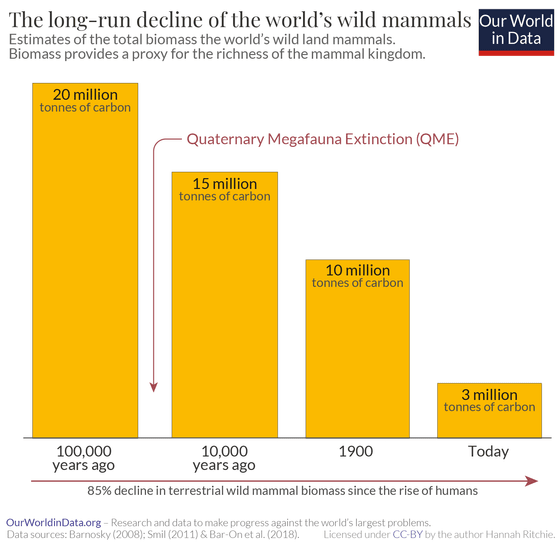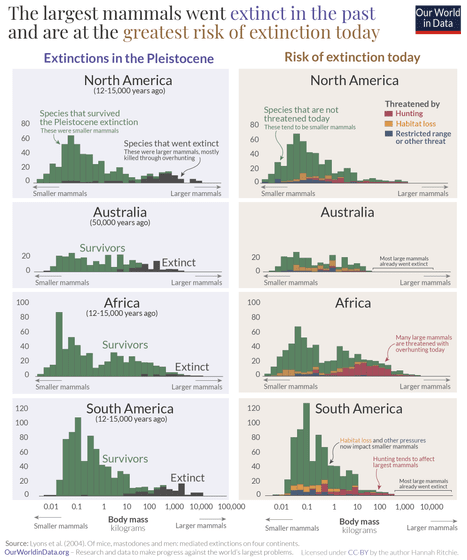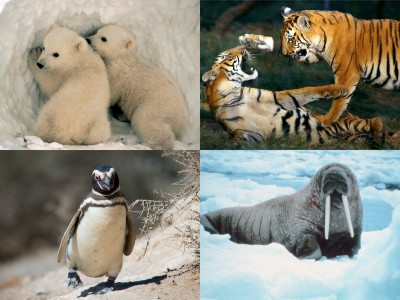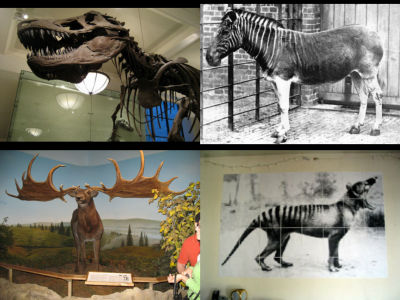`` 34% of mammals in the world are humans and wild animals are only 4% '' 9 unknown mammals' knowledge

Our World in Data, which summarizes global issues such as climate change and destruction of nature, has summarized the current state of mammals, including humans, into nine.
Mammals - Our World in Data
·table of contents
◆ 1: The biomass of wild mammals has decreased by 85% since the appearance of mankind
◆ 2: Wild animals account for only 4% of the world's mammals
◆ 3: Human ancestors mass extinction of large mammals
◆ 4: Where do the most unique mammals live?
◆ 5: A quarter of the world's mammals are on the brink of extinction
◆ 6: Giant mammals that are disappearing
◆ 7: The population of elephants has drastically decreased due to poaching
◆ 8: Some rhinos have revived, but some rhinos are on the verge of extinction
◆ 9: Whales are recovering little by little
◆ 1: The biomass of wild mammals has decreased by 85% since the appearance of mankind
The number of individuals is often used as an indicator of ecosystem richness, but scientists often use the indicator 'biomass' because giant elephants and small mice are counted in the same way. This is an index that expresses how many animals exist based on the weight of carbon, which is the basic substance that makes up living things.
About 100,000 years ago, when human ancestors still lived in Africa, the biomass of wild animals on earth was 20 million tons. However, as humans gradually began to prosper, they hunted down large mammals. In 1900, it was half of what it was 100,000 years ago, and today it is only 3 million tons, or only 15% of what it was 100,000 years ago.

◆ 2: Wild animals account for only 4% of the world's mammals
While wild animals are declining, humans and livestock are proliferating, and humans and livestock account for 96% of mammals on the ground.
The breakdown is as follows. Only 4% are wild animals, 34% are humans, and the remaining 62% are livestock. Among livestock, cows account for 35% of all mammalian biomass, pigs 12% and buffalo 5%, followed by goats, sheep, horses and pets. In addition, chickens, which are representative livestock along with cows and pigs, are birds, so they are not covered in this figure.

◆ 3: Human ancestors mass extinction of large mammals
Many wild animals have decreased due to environmental destruction in recent years, so it is often thought that ``humans have begun to threaten wildlife only recently.'' However, it is known that the ancestors of mankind before civilization did not harmonize with nature, but drove many wild animals to extinction in the process of spreading from Africa to all over the world.
According to a survey by Our World in Data, between 52,000 and 9000 BC, 178 types of `` megafauna '', large mammals weighing 44 kg or more, became extinct. This phenomenon, called the '

◆ 4: Where do the most unique mammals live?
Among the disappearing mammals, scientists are paying particular attention to
Below is a map showing which countries have the most endemic species. The darker the color, the more endemic species live. Islands and continents separated from other regions by the sea have the most endemic species. Specifically, Indonesia, which is located in the tropics, has the highest number of endemic species with 281 species. More than 200 species of endemic mammals also live in Australia and Madagascar in Africa.
◆ 5: A quarter of the world's mammals are on the brink of extinction
A large population of endemic mammals means a large population of endangered mammals. Below is a graph of countries with red-listed mammals classified as threatened, with Indonesia again topping the list as it has the most endemic species. In addition, Mexico, India, Brazil, and China, which are developing along with economic development, are also ranked high, and it is said that one-fourth of the mammals in the world are in danger of extinction.
◆ 6: Giant mammals that are disappearing
As mentioned above, human beings have exterminated large mammals in large numbers as they advance from Africa to various parts of the world, and the crisis is still continuing. Among the following, the left column shows mammals that died out in the Pleistocene epoch from about 2.58 million years ago to about 11,700 years ago in black, and mammals that survived in green. It's from South America. Since the body is smaller on the left and larger on the right, it can be seen that extinct mammals are biased towards large mammals. Similarly, the graphs in the right column show animals not currently threatened with extinction in green, and mammals that are threatened by hunting, habitat loss, or other threats in red, yellow, and blue, respectively. disappearance has been shown to be skewed toward large mammals.

From the graph above, it can be seen that from ancient times to the present day, large mammals are mainly killed by human hunting, that is, overhunting. Ancient humans hunted and ate megafauna primarily for food, but even today large mammals are killed for their tusks, bones, or just for fun.
◆ 7: Elephant populations are declining due to poaching
Elephants, the largest mammals on earth, are the most common large mammals killed by poaching. In particular, the African elephant population, which is seriously poached for its ivory, fell from 26 million in 1500 to 286,000 in 1995. Since then, the population has been recovering slightly, but as of 2015, the number was about 415,000, which is only 4% of the 10 million head about 100 years ago.
◆ 8: Some rhinos have revived, but some rhinos are on the verge of extinction
Rhinoceros, whose horns are valued in Chinese herbal medicine, are also threatened by poaching, with four out of five rhino species listed as endangered.
For example, the northern white rhinoceros, a subspecies of white rhinoceros, is in a state of wild extinction with only two living at the time of writing the article. Moreover, the last male died in March 2018, leaving only the female to survive.
One of the few successful examples of species conservation efforts is the southern white rhinoceros. Poaching reduced the southern white rhino to 20 in 1895, but as a result of strict protection in African nature reserves, the population recovered 1,000 times to 21,000 in a century. Did.
◆ 9: Whales are recovering little by little
On the other hand, looking at the sea, whales, which are large mammals of the sea, have also greatly decreased in number due to whaling. In particular, the number of fin whales, which were actively hunted, has decreased by 98.5%.
However, due to the development of technology, whale oil has become unnecessary, and international efforts have reduced whaling, and the population of some species of whales is recovering. In this regard, Our World in Data said, ``Whaling is one of the successful examples of nature conservation. Animals that were once in high demand around the world have been saved from the danger of extinction through alternative technologies and international cooperation. Many mammals are still in a situation similar to that of whales when they were on the brink of extinction in the 1960s, and the decline of whaling may give us hope that things can be turned around. I can't do it.'
Related Posts:
in Creature, Posted by log1l_ks







